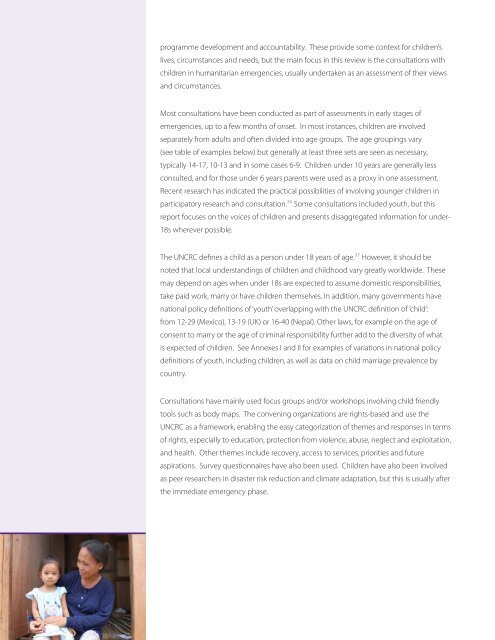putting-children-at-the-heart_full_text_final
putting-children-at-the-heart_full_text_final
putting-children-at-the-heart_full_text_final
- No tags were found...
Create successful ePaper yourself
Turn your PDF publications into a flip-book with our unique Google optimized e-Paper software.
programme development and accountability. These provide some con<strong>text</strong> for <strong>children</strong>’s<br />
lives, circumstances and needs, but <strong>the</strong> main focus in this review is <strong>the</strong> consult<strong>at</strong>ions with<br />
<strong>children</strong> in humanitarian emergencies, usually undertaken as an assessment of <strong>the</strong>ir views<br />
and circumstances.<br />
Most consult<strong>at</strong>ions have been conducted as part of assessments in early stages of<br />
emergencies, up to a few months of onset. In most instances, <strong>children</strong> are involved<br />
separ<strong>at</strong>ely from adults and often divided into age groups. The age groupings vary<br />
(see table of examples below) but generally <strong>at</strong> least three sets are seen as necessary,<br />
typically 14-17, 10-13 and in some cases 6-9. Children under 10 years are generally less<br />
consulted, and for those under 6 years parents were used as a proxy in one assessment.<br />
Recent research has indic<strong>at</strong>ed <strong>the</strong> practical possibilities of involving younger <strong>children</strong> in<br />
particip<strong>at</strong>ory research and consult<strong>at</strong>ion. 36 Some consult<strong>at</strong>ions included youth, but this<br />
report focuses on <strong>the</strong> voices of <strong>children</strong> and presents disaggreg<strong>at</strong>ed inform<strong>at</strong>ion for under-<br />
18s wherever possible.<br />
The UNCRC defines a child as a person under 18 years of age. 37 However, it should be<br />
noted th<strong>at</strong> local understandings of <strong>children</strong> and childhood vary gre<strong>at</strong>ly worldwide. These<br />
may depend on ages when under 18s are expected to assume domestic responsibilities,<br />
take paid work, marry or have <strong>children</strong> <strong>the</strong>mselves. In addition, many governments have<br />
n<strong>at</strong>ional policy definitions of ‘youth’ overlapping with <strong>the</strong> UNCRC definition of ’child’:<br />
from 12-29 (Mexico), 13-19 (UK) or 16-40 (Nepal). O<strong>the</strong>r laws, for example on <strong>the</strong> age of<br />
consent to marry or <strong>the</strong> age of criminal responsibility fur<strong>the</strong>r add to <strong>the</strong> diversity of wh<strong>at</strong><br />
is expected of <strong>children</strong>. See Annexes I and II for examples of vari<strong>at</strong>ions in n<strong>at</strong>ional policy<br />
definitions of youth, including <strong>children</strong>, as well as d<strong>at</strong>a on child marriage prevalence by<br />
country.<br />
Consult<strong>at</strong>ions have mainly used focus groups and/or workshops involving child friendly<br />
tools such as body maps. The convening organiz<strong>at</strong>ions are rights-based and use <strong>the</strong><br />
UNCRC as a framework, enabling <strong>the</strong> easy c<strong>at</strong>egoriz<strong>at</strong>ion of <strong>the</strong>mes and responses in terms<br />
of rights, especially to educ<strong>at</strong>ion, protection from violence, abuse, neglect and exploit<strong>at</strong>ion,<br />
and health. O<strong>the</strong>r <strong>the</strong>mes include recovery, access to services, priorities and future<br />
aspir<strong>at</strong>ions. Survey questionnaires have also been used. Children have also been involved<br />
as peer researchers in disaster risk reduction and clim<strong>at</strong>e adapt<strong>at</strong>ion, but this is usually after<br />
<strong>the</strong> immedi<strong>at</strong>e emergency phase.


